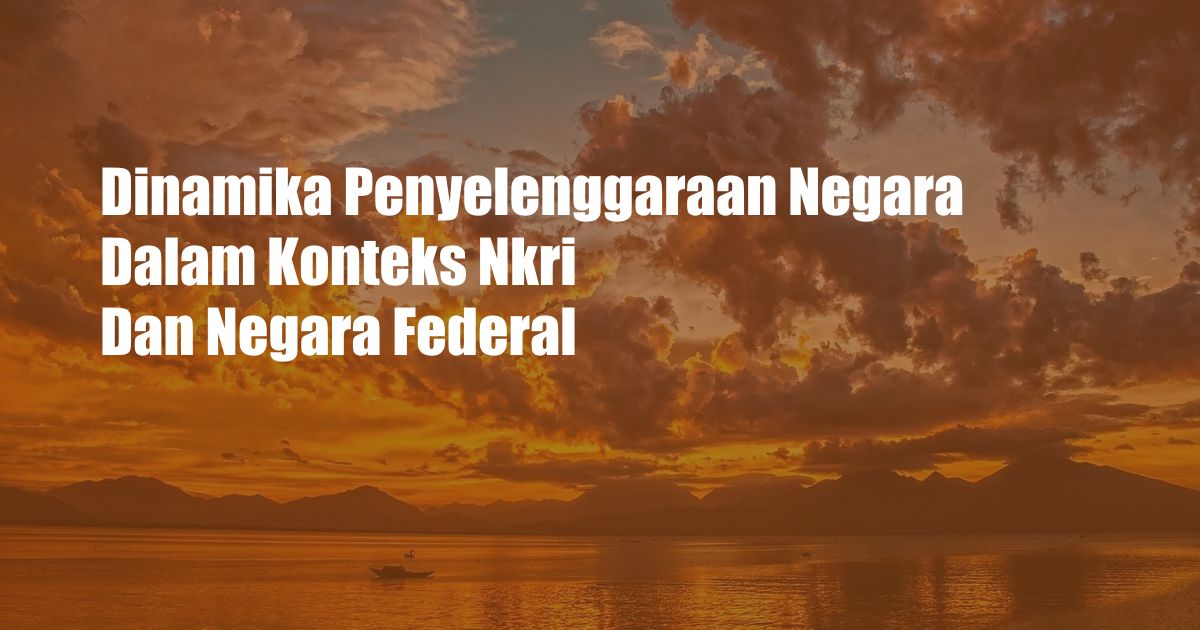
Dinamika Penyelenggaraan Negara dalam Konteks NKRI dan Negara Federal
In the intricate tapestry of international relations, the organizational structure of states has captivated scholars and statesmen alike. Two distinct models, the unitary state (as exemplified by Indonesia’s NKRI) and the federal state, present contrasting approaches to governance and distribution of power.
A unitary state, like Indonesia, centralizes authority within a single government body. Subnational entities, such as provinces and municipalities, derive their powers from the central authority and operate within the parameters set by the national constitution. This centralized model fosters uniformity in policy and administration, promoting national cohesion and a sense of unity.
Federalism: Power Sharing and Regional Autonomy
In contrast to unitary states, federal systems devolve power between a central government and constituent states or provinces. The division of authority is enshrined in a federal constitution, which allocates specific powers to each level of government. This power-sharing arrangement fosters regional autonomy, allowing states to tailor policies and programs to their unique needs and circumstances.
Federalism has gained prominence in diverse nations, including the United States, Canada, and Germany. It accommodates diverse cultures, regional interests, and economic disparities, promoting inclusivity and fostering a sense of belonging among constituent states. However, federal systems may also face challenges in coordinating policies, balancing regional interests, and resolving conflicts between different levels of government.
Comparing NKRI and Federal States
The unitary structure of NKRI contrasts markedly with the federal systems adopted by many other nations. In Indonesia, the central government holds primary authority, with regional governments exercising limited powers delegated by the national government. This centralized approach ensures a degree of consistency and uniformity in policies and administration across the vast archipelago.
Federal states, on the other hand, grant significant autonomy to constituent states, allowing them to enact their own laws and policies within the framework of the federal constitution. This decentralized approach fosters regional diversity and self-governance, but it can also lead to disparities in policies and a potential for conflict between different levels of government.
The Evolution of Federalism and the Challenges of Decentralization
Federalism has evolved over time, responding to changing political, economic, and social realities. In recent decades, there has been a trend towards greater decentralization, as central governments seek to devolve power to regional and local authorities.
However, decentralization can pose challenges, including:
- Maintaining national cohesion and unity
- Coordinating policies and ensuring consistency
- Addressing regional disparities and inequities
Tips for Balancing Centralization and Decentralization
Striking a balance between centralization and decentralization is crucial for effective governance. Experts advise:
- Clearly defining the roles and responsibilities of each level of government
- Establishing mechanisms for cooperation and coordination between different levels of government
- Promoting fiscal responsibility and ensuring accountability for the use of public resources
By implementing these principles, governments can harness the benefits of both centralization and decentralization, fostering national unity, regional autonomy, and responsive governance.
FAQs on NKRI and Federalism
Q: What is the main difference between NKRI and a federal state?
A: NKRI is a unitary state, with power concentrated in the central government. Federal states divide power between a central government and constituent states.
Q: What are the advantages of federalism?
A: Federalism promotes regional autonomy, accommodates diversity, and fosters inclusivity.
Q: What are the challenges of decentralization?
A: Decentralization can lead to regional disparities, inconsistencies in policies, and potential conflicts between different levels of government.
Conclusion
The dynamics of state organization present governments with a multifaceted decision: whether to adopt a unitary structure like NKRI or embrace the decentralized approach of federalism. Both models have their merits, and the choice depends on the specific needs, history, and aspirations of each nation. Understanding the differences and complexities of these governance models is essential for fostering a deeper appreciation of the diverse political landscapes that shape our world.
Are you intrigued by the topic of state organization and its impact on governance and society? Share your thoughts and perspectives in the comments section below.
